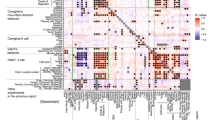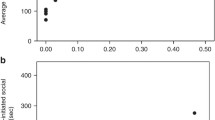Abstract
With temperature and humidity controlled, responses of an infant crab-eating macaque to mother surrogates changed significantly with changes in illumination. In addition, during 77 days of observations, contact with a soft, nonfeeding surrogate was significantly greater than was contact with a stiff, feeding surrogate. The preference for the soft surrogate is consistent with results reported by Harlow for rhesus infants.
Similar content being viewed by others
References
FURCHNER, C.S., & HARLOW, H.F. 1969. Preference for various surrogate surfaces among infant rhesus monkeys. Psychonomic Science. 17(5), 279–280.
HARLOW, H.F. 1958. The nature of love. The American Psychologist, 13, 673–685.
HARLOW, H.F. 1959a. Basic social capacity of primates. Human Biology, 31, 40–53.
HARLOW, H.F. 1959b. Love in infant monkeys. Scientific American. 200(6), 68–74.
HARLOW, H.F. 1960. Primary affectional patterns in primates. The American Journal of Orthopsychiatry, 30, 676–684.
HARLOW, H., & HARLOW, M. 1966. Learning to love. American Scientist. 54(3), 244–272.
HARLOW, H., & HARLOW, M. 1967. The young monkeys. Psychology Today. 1(5), 40–47.
HARLOW, H.F., & SUOMI, S.J. 1970. Nature of love-simplified. The American Psychologist. 25(1), 161–168.
HARLOW, H.F., & ZIMMERMAN, R.R. 1958. The development of affectional responses. Proceedings of the American Philosophical Society. 102(5), 501–509.
HARLOW, H.F., & ZIMMERMAN, R.R. 1959. Affectional responses in infant monkeys. Science. 130(3373), 421–432.
HILL, W.C.O. 1974. Primates: Comparative anatomy and taxonomy (Vol. 7). Cynopithecinae: Cercocebus, Macaca, Cynopithecus. New York: John Wiley & Sons.
ROSENBLUM, L.A., & HARLOW, H.F. 1963a. Approach-avoidance conflicts in the mother-surrogate situation. Psychological Reports, 12, 83–85.
ROSENBLUM, L.A., & HARLOW, H.F. 1963b. Generalisation of affectional responses in rhesus monkeys. Perceptual and Motor Skills, 16, 561–564.
SCHOLANDER, P.F., HOCK, R., WALTERS, V., JOHNSON, F., & IRVING, C. 1950. Heat regulation in some arctic and tropical mammals and birds. Biological Bulletin, 99, 237–258.
Author information
Authors and Affiliations
Additional information
This study was supported in part by a Grant-in-Aid of Research from Indiana University Southeast. J. B. Sharp, DVM, Director, Animal Care Center, School of Medicine, University of Louisville, served as consultant and provided medical care for the animal. Undergraduate students B. Behney, W. Cooke, K. DaVania, P. Deuser, J. Van Hook, and J. Walls were responsible for most of the data collection and animal care.
An erratum for this article can be found at http://dx.doi.org/10.1007/BF03394831
Rights and permissions
About this article
Cite this article
Ainsworth, L.L., Baker, C.D. Effects of Illumination Changes on Infant Monkey Contacts with Surrogates. Psychol Rec 32, 513–518 (1982). https://doi.org/10.1007/BF03394809
Published:
Issue Date:
DOI: https://doi.org/10.1007/BF03394809




